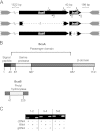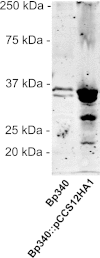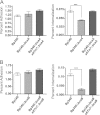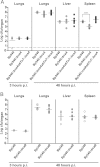Characterization of BcaA, a putative classical autotransporter protein in Burkholderia pseudomallei
- PMID: 23340315
- PMCID: PMC3639613
- DOI: 10.1128/IAI.01453-12
Characterization of BcaA, a putative classical autotransporter protein in Burkholderia pseudomallei
Abstract
Burkholderia pseudomallei is a tier 1 select agent, and the causative agent of melioidosis, a disease with effects ranging from chronic abscesses to fulminant pneumonia and septic shock, which can be rapidly fatal. Autotransporters (ATs) are outer membrane proteins belonging to the type V secretion system family, and many have been shown to play crucial roles in pathogenesis. The open reading frame Bp1026b_II1054 (bcaA) in B. pseudomallei strain 1026b is predicted to encode a classical autotransporter protein with an approximately 80-kDa passenger domain that contains a subtilisin-related domain. Immediately 3' to bcaA is Bp11026_II1055 (bcaB), which encodes a putative prolyl 4-hydroxylase. To investigate the role of these genes in pathogenesis, large in-frame deletion mutations of bcaA and bcaB were constructed in strain Bp340, an efflux pump mutant derivative of the melioidosis clinical isolate 1026b. Comparison of Bp340ΔbcaA and Bp340ΔbcaB mutants to wild-type B. pseudomallei in vitro demonstrated similar levels of adherence to A549 lung epithelial cells, but the mutant strains were defective in their ability to invade these cells and to form plaques. In a BALB/c mouse model of intranasal infection, similar bacterial burdens were observed after 48 h in the lungs and liver of mice infected with Bp340ΔbcaA, Bp340ΔbcaB, and wild-type bacteria. However, significantly fewer bacteria were recovered from the spleen of Bp340ΔbcaA-infected mice, supporting the idea of a role for this AT in dissemination or in survival in the passage from the site of infection to the spleen.
Figures






Similar articles
-
Functional characterization of Burkholderia pseudomallei trimeric autotransporters.Infect Immun. 2013 Aug;81(8):2788-99. doi: 10.1128/IAI.00526-13. Epub 2013 May 28. Infect Immun. 2013. PMID: 23716608 Free PMC article.
-
Systematic mutagenesis of genes encoding predicted autotransported proteins of Burkholderia pseudomallei identifies factors mediating virulence in mice, net intracellular replication and a novel protein conferring serum resistance.PLoS One. 2015 Apr 1;10(4):e0121271. doi: 10.1371/journal.pone.0121271. eCollection 2015. PLoS One. 2015. PMID: 25830295 Free PMC article.
-
Functional characterizations of effector protein BipC, a type III secretion system protein, in Burkholderia pseudomallei pathogenesis.J Infect Dis. 2015 Mar 1;211(5):827-34. doi: 10.1093/infdis/jiu492. Epub 2014 Aug 26. J Infect Dis. 2015. PMID: 25165162
-
The molecular and cellular basis of pathogenesis in melioidosis: how does Burkholderia pseudomallei cause disease?FEMS Microbiol Rev. 2009 Nov;33(6):1079-99. doi: 10.1111/j.1574-6976.2009.00189.x. Epub 2009 Aug 5. FEMS Microbiol Rev. 2009. PMID: 19732156 Review.
-
Melioidosis: molecular aspects of pathogenesis.Expert Rev Anti Infect Ther. 2014 Dec;12(12):1487-99. doi: 10.1586/14787210.2014.970634. Epub 2014 Oct 14. Expert Rev Anti Infect Ther. 2014. PMID: 25312349 Free PMC article. Review.
Cited by
-
Phylogenetic Classification and Functional Review of Autotransporters.Front Immunol. 2022 Jul 1;13:921272. doi: 10.3389/fimmu.2022.921272. eCollection 2022. Front Immunol. 2022. PMID: 35860281 Free PMC article. Review.
-
Characterization of an autotransporter adhesin protein shared by Burkholderia mallei and Burkholderia pseudomallei.BMC Microbiol. 2014 Apr 14;14:92. doi: 10.1186/1471-2180-14-92. BMC Microbiol. 2014. PMID: 24731253 Free PMC article.
-
Efflux pump-mediated drug resistance in Burkholderia.Front Microbiol. 2015 Apr 14;6:305. doi: 10.3389/fmicb.2015.00305. eCollection 2015. Front Microbiol. 2015. PMID: 25926825 Free PMC article.
-
Crystal structure of a subtilisin-like autotransporter passenger domain reveals insights into its cytotoxic function.Nat Commun. 2023 Mar 1;14(1):1163. doi: 10.1038/s41467-023-36719-2. Nat Commun. 2023. PMID: 36859523 Free PMC article.
-
Antibodies against In Vivo-Expressed Antigens Are Sufficient To Protect against Lethal Aerosol Infection with Burkholderia mallei and Burkholderia pseudomallei.Infect Immun. 2017 Jul 19;85(8):e00102-17. doi: 10.1128/IAI.00102-17. Print 2017 Aug. Infect Immun. 2017. PMID: 28507073 Free PMC article.
References
-
- Holden MT, Titball RW, Peacock SJ, Cerdeno-Tarraga AM, Atkins T, Crossman LC, Pitt T, Churcher C, Mungall K, Bentley SD, Sebaihia M, Thomson NR, Bason N, Beacham IR, Brooks K, Brown KA, Brown NF, Challis GL, Cherevach I, Chillingworth T, Cronin A, Crossett B, Davis P, DeShazer D, Feltwell T, Fraser A, Hance Z, Hauser H, Holroyd S, Jagels K, Keith KE, Maddison M, Moule S, Price C, Quail MA, Rabbinowitsch E, Rutherford K, Sanders M, Simmonds M, Songsivilai S, Stevens K, Tumapa S, Vesaratchavest M, Whitehead S, Yeats C, Barrell BG, Oyston PC, Parkhill J. 2004. Genomic plasticity of the causative agent of melioidosis, Burkholderia pseudomallei. Proc. Natl. Acad. Sci. U. S. A. 101:14240–14245 - PMC - PubMed
-
- Sprague LD, Neubauer H. 2004. Melioidosis in animals: a review on epizootiology, diagnosis and clinical presentation. J. Vet. Med. B Infect. Dis. Vet. Public Health 51:305–320 - PubMed
-
- Wiersinga WJ, Currie BJ, Peacock SJ. 2012. Melioidosis. N. Engl. J. Med. 367:1035–1044 - PubMed
Publication types
MeSH terms
Substances
Grants and funding
LinkOut - more resources
Full Text Sources
Other Literature Sources

